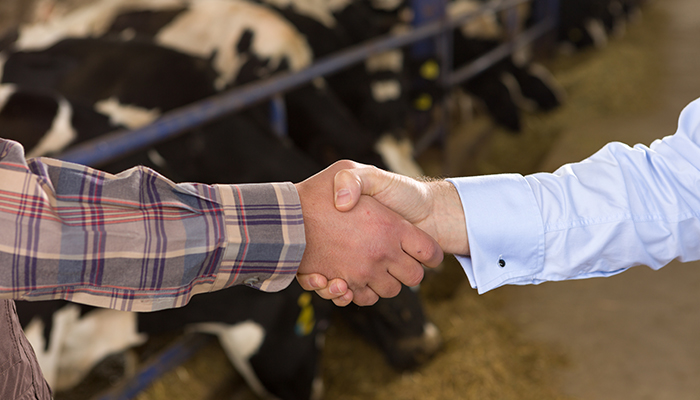16 May 2023
Examining the collaborative farming options

Collaborative farming options are attractive arrangements for young farmers to enter a farming business. Alternatively, there are also farmers who have no identified successor and are ready to step back or retire.
In this article, Gordon Peppard, Teagasc Farm Business Structures Specialist, details a number of collaborative farming options including: registered farm partnerships; share farming; long-term land leasing; and contract dairy heifer rearing.
Registered Farm Partnerships (RFP) – family situations
In some family farm scenarios, parents may not currently be in a position to transfer the farm to a child. There are often real concerns such as: total family income, security for parents and family members who still have to be provided for. These concerns can be alleviated by forming a registered partnership as an interim step before succession.
Benefits to parents and the young farmer
Parents are not currently giving up control of the farm assets, they are sharing them with their child. Ownership of land, buildings etc. are retained and are licensed for use by the RFP. Stock and machinery are transferred and become partnership assets. The partnership allows the son/daughter to have significant input into the decision making, management, and gives them the experience of running the farm through an agreed profit sharing ratio.
Registered Farm Partnership – Non-family
Partnership with other farmer(s) may offer the opportunity for increased scale, making use of existing facilities, drawing on a wider skills mix; increased labour availability and efficiency.
When two or more people come together, they bring different knowledge/skills to the business, which can improve work-life balance through a fair distribution of the workload.
Tax Incentives for the formation of registered farm partnerships
Depending on the profit share ratio, income tax at the low rate may be maximised. Succession farm partnerships can provide an annual income tax credit of €5,000 for up to five years. Young trained farmers are eligible for 100% stock relief in the first four years and enhanced stock relief is available to other partners in the RFP at the rate of 50%.
On-Farm Investment and Direct Payment Schemes
RFPs may qualify for a double TAMS grant investment ceiling of up to €160,000. A qualifying young trained farmer may qualify for 60% grant aid on the first investment ceiling of €90,000. There is also a payment of c. €170 per hectare for a max. of 5 years through the Complimentary Income Support for Young Farmers Scheme, where there is a qualifying young trained farmer in the RFP.
Share farming
Share farming involves two separate farming businesses operating on the same land. In a share farming agreement, the risks/rewards, and farm inputs/outputs are shared on an agreed basis. Each person must complete their own financial plan for their own respective businesses to make ensure the business is financially sustainable.
Benefits to landowners and share farmers
An opportunity for older farmers who want to continue farming and who do not want to retire. They can enter an arrangement with a younger person to share the workload, income and costs. The young motivated person will bring attributes such as new skills, a strong work ethic, modern technology and a desire to develop a profitable enterprise. Both parties have a vested interest in the overall farm business.
Share farming allows a young person an entry to farming and to build their own independent business and the opportunity to reward ability and efficiency.
Long-term land leasing
Benefits to Lessor
Income received from the lease and value of any BISS Entitlement is tax free subject to the limits in Table 1 below. These limits can be doubled where land is jointly owned.
Table 1: Income tax free threshold for different lease lengths
| Term of lease (years) | Max. tax free income/year (€) |
|---|---|
| 5-6 | 18,000 |
| 7-9 | 22,500 |
| 10-14 | 30,000 |
| >15 | 40,000 |
Benefits to Lessee
Security of tenure to expand their business, make future plans and undertake capital expenditure on the land if term and rental price allow.
Contract dairy heifer rearing
Contract rearing may be an alternative or additional enterprise to existing farming enterprises. For contract rearing to be successful, it has to be a WIN: WIN scenario for all parties involved. The rearer needs to get paid adequately to cover variable and fixed costs, whilst also leaving a margin to cover their land, labour, facilities and management. Advantages to the rearer are: regular cash flow; no money tied up in stock; and the risk of volatile beef price and market are removed. The dairy farmer requires a heifer returned in calf, well reared and in good condition. The main advantages are the opportunity to milk more cows on the home farm, less groups of stock, easing Nitrates regulations and providing more land, labour and facilities to the dairy business.
Good communication, honesty, trust and regular contact to make key decisions on the heifer’s progress are essential to the success of contract rearing.
Conclusions
Collaborative farming arrangements are options to encourage young farmers into farming business. Each arrangement requires excellent planning and financial/legal advice should always be sought before entering into any of these arrangements.
Specimen template agreements for all the collaborative arrangements are available on the Collaborative Farming section of the Teagasc website.
Also read: Have you considered a registered farm partnership?
